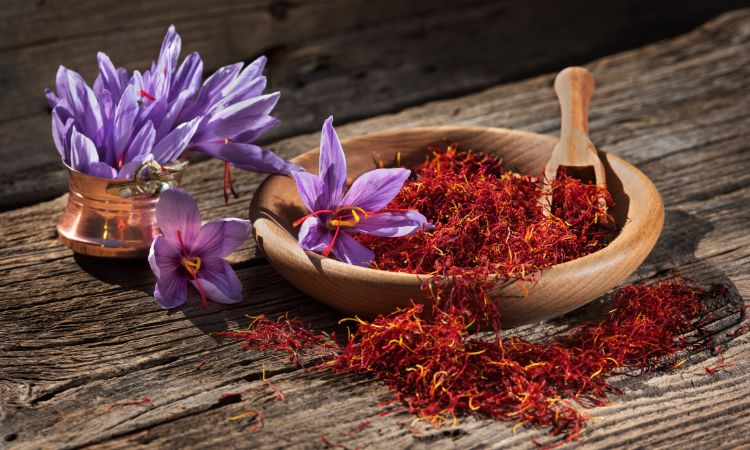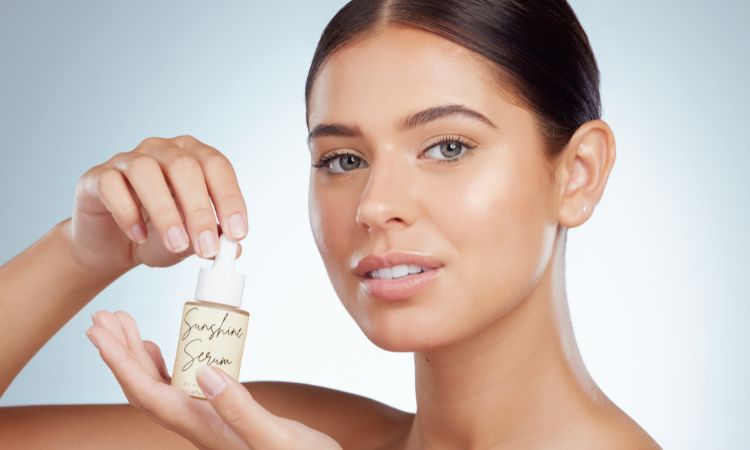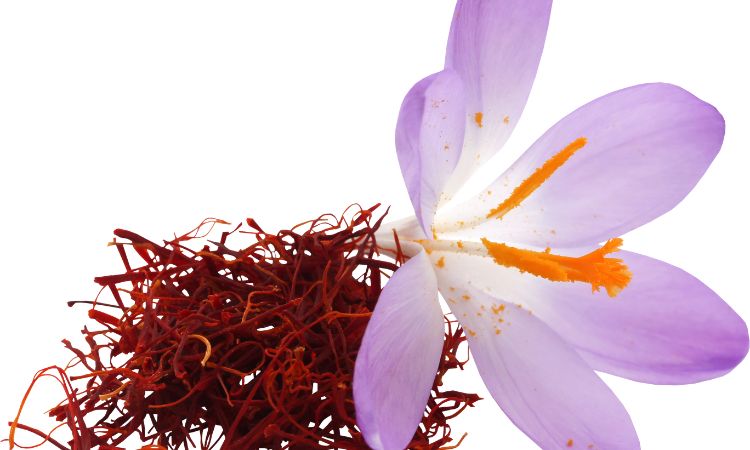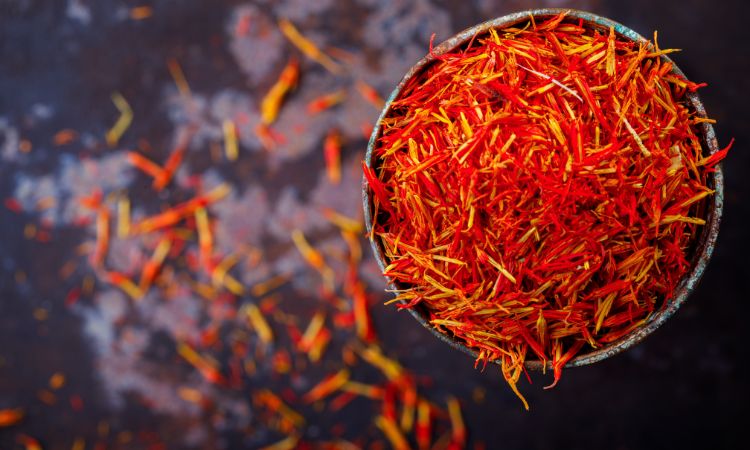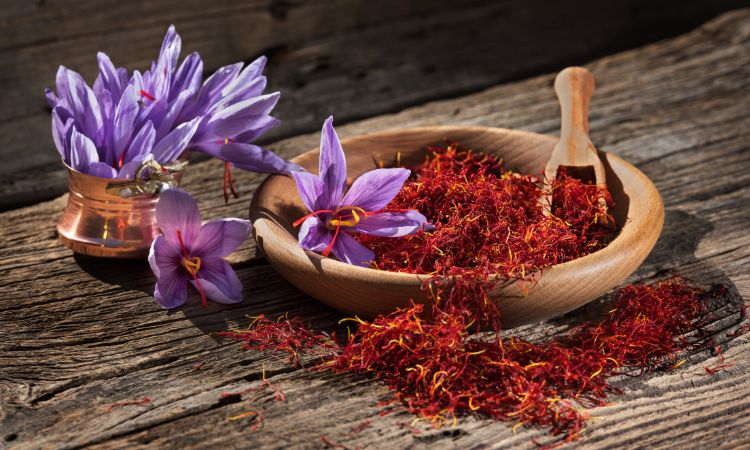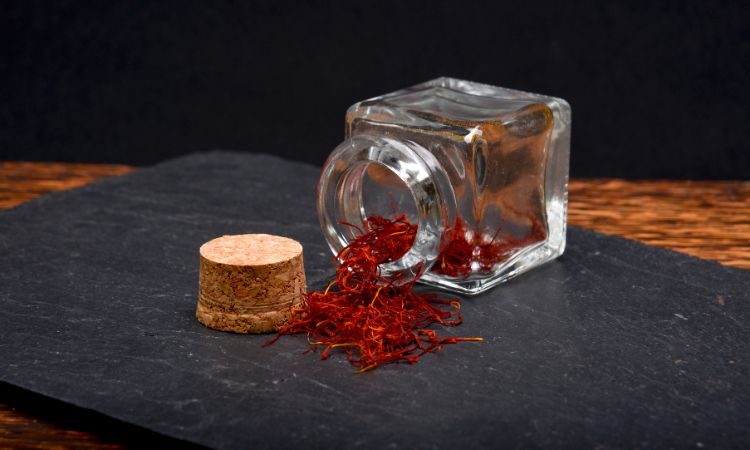Do you dream of radiant, youthful skin? It might be closer than you think. Saffron, a prized spice, is making waves in skincare. It comes from the delicate Crocus sativus flower and is packed with antioxidants like crocin and crocetin. These offer many benefits for your skin.
But why is saffron so special? Can it really unlock your skin’s full potential? Discover the answer as we explore saffron’s legacy and how it can change your skincare routine.
Key Takeaways of Saffron Skincare Benefits
- Saffron is a rich source of antioxidants that protect skin from UV damage and premature aging.
- Saffron’s anti-inflammatory properties can soothe skin conditions like eczema, acne, and rosacea.
- Crocin, the main compound in saffron, has skin-lightening abilities to reduce hyperpigmentation and dark spots.
- Saffron’s exfoliating properties can improve skin texture and reveal a radiant, youthful glow.
- Incorporating saffron into your daily skincare routine can deliver long-term benefits for a healthy, glowing complexion.
The Ancient Legacy of Saffron in Beauty Rituals
Saffron has been a key part of beauty rituals for over 3,000 years. This valuable spice comes from the delicate stigmas of crocus flowers. It was highly valued by ancient civilizations for its skincare benefits.
From the grand palaces of Persia to Cleopatra’s lavish beauty routines, saffron was a symbol of luxury. It was seen as a sign of wealth and beauty.
Historical Use in Egyptian and Persian Cultures
In ancient Egypt, saffron was a prized ingredient in skincare. Cleopatra used saffron in her baths to nourish her skin. This practice was believed to improve her beauty.
In Persian culture, saffron was also highly valued. It was used in Ayurvedic medicine, religious ceremonies, and art. This shows its wide range of uses.
Traditional Medicinal Applications
Saffron was used for more than just beauty in ancient times. In Greek and Hindu traditions, it was known for treating skin problems. It could help with acne and speed up wound healing.
Its powerful antioxidants and anti-inflammatory properties made it a popular choice. It was seen as a key to healthy skin.
From Culinary Spice to Skincare Superstar
Today, saffron is valued more for its skincare benefits than as a spice. Its bioactive compounds, like crocin and crocetin, are known for their skin benefits. They help with skin regeneration, reducing pigmentation, and fighting aging.
This has made saffron a top choice in skincare. It’s a true superstar in the world of beauty.
Understanding Saffron: From Harvest to Skincare
Saffron’s story is one of rarity and respect. It comes from the vibrant Crocus sativus flower. This crop is picked by hand, one stigma at a time. Saffron cultivation has been around for ages. The Mediterranean, especially Provence, France, is perfect for growing it.
Each flower gives only three threads, making saffron very expensive. The extraction process is detailed. It involves picking, drying, and handling the stigmas carefully. This ensures saffron’s high quality, making it popular in clean beauty.
In skincare, saffron is mixed with oils, water, or milk. It’s rare and hard to get, which makes it valuable. Its antioxidants, anti-inflammatory, and brightening effects are key in high-end products.
| Saffron Cultivation Fact | Statistic |
|---|---|
| Saffron Harvest Season | Late October to Early November |
| Key Saffron Cultivation Region | Provence, France |
| Saffron Flower Yield per Plant | 3 Stigmas |
The art of growing saffron and its cultural value have made it a top choice in clean beauty. Exploring the benefits of saffron for skin reveals its journey. It shows how saffron can make skin look radiant and healthy.
Key Compounds and Their Skin Benefits
Saffron is the world’s most expensive spice and a treasure for your skin. It’s packed with compounds like crocin, crocetin, and safranal. These are the heart of saffron’s benefits for your skin.
Crocin and Its Antioxidant Properties
Crocin is the carotenoid that makes saffron golden. It’s a strong antioxidant. It fights off free radicals, protecting your skin from UV rays and pollution.
By stopping free radicals, crocin makes your skin brighter and more even. It also reduces blemishes and dark spots.
Crocetin for Skin Regeneration
Crocetin is key for skin renewal. It boosts collagen production. Collagen keeps your skin young and firm.
With more collagen, your skin looks smoother and younger. Fine lines and wrinkles fade, leaving your skin radiant.
Safranal’s Anti-inflammatory Effects
Safranal is what gives saffron its unique smell. It’s great for calming inflammation in the skin. It soothes redness and irritation.
It helps with conditions like eczema, psoriasis, and rosacea. Safranal makes your skin healthier and more balanced.
These three compounds work together to protect and nourish your skin. They fight free radicals, boost collagen, and reduce inflammation. Saffron is a natural way to get glowing, healthy skin.
| Saffron Compound | Skin Benefit |
|---|---|
| Crocin | Antioxidant properties, skin brightening, evening out skin tone |
| Crocetin | Skin regeneration, collagen production, reducing fine lines and wrinkles |
| Safranal | Anti-inflammatory effects, soothing irritated skin, managing conditions like eczema and rosacea |
Saffron Skincare Benefits: A Comprehensive Guide
Saffron, known as the “golden spice,” is more than just a tasty ingredient. It’s also a key player in skincare. Once prized by Egyptians and Persians, saffron is now celebrated for its skin benefits. It offers natural UV protection and fights aging signs, making it a versatile skincare ally.
Saffron’s power as a natural antioxidant is impressive. Its compounds, crocin and Safranal, fight off free radicals. This protects skin cells from damage, reducing aging signs and boosting skin renewal.
Saffron also shines in fighting acne and rosacea with its anti-inflammatory effects. It calms redness and irritation, helping to balance and brighten the skin. Plus, it can reduce hyperpigmentation, making the skin look brighter.
But there’s more. Saffron also boosts skin hydration, leaving it soft and glowing. It can improve skin texture, reduce fine lines, and even increase collagen. This makes the skin look younger and firmer.
If you want to protect your skin, tackle specific issues, or just get a radiant glow, saffron is a great choice. Always talk to a dermatologist or skincare expert before adding it to your routine. They can help make sure it’s right for your skin.
Natural Anti-Aging Properties of Saffron
Saffron is more than a colorful spice. It’s a treasure for fighting aging signs, making it a top skincare choice. Let’s explore how saffron naturally fights aging.
Collagen Production Enhancement
Collagen, key for skin elasticity, decreases with age. Saffron helps by boosting collagen production. Its compounds, crocin and crocetin, encourage new collagen, making skin firm and youthful.
Wrinkle Reduction Capabilities
Saffron’s antioxidants fight wrinkles. Safranal in saffron protects collagen and regenerates skin cells. This reduces fine lines and wrinkles, giving skin a fresh look.
Adding saffron skincare to your routine can change your anti-aging game. This spice can give you the glowing, youthful skin you want.
Saffron for Skin Brightening and Pigmentation
Discover how saffron can transform your skin! This precious spice is known for brightening and evening out your skin tone. It’s a natural superstar in skincare, targeting the causes of uneven pigmentation and dullness.
Saffron’s magic lies in its ability to block melanin production. Its powerful antioxidant, crocin, stops the enzyme tyrosinase. This leads to fewer dark spots and hyperpigmentation, revealing a brighter complexion.
Saffron also has anti-inflammatory properties. Compounds like safranal soothe redness and irritation. It calms the skin, creating a radiant, healthy glow. Saffron is a natural alternative to harsh chemical lighteners, offering a gentler way to achieve an even, luminous complexion.
| Saffron Skin Brightening Benefits | Clinical Results | Customer Feedback |
|---|---|---|
| Reduces the appearance of fine lines and wrinkles | 100% saw a decrease in the look of fine lines & wrinkles in a clinical test involving 32 subjects | 93% felt their skin looked more radiant |
| Decreases hyperpigmentation and dark spots | 78% demonstrated a statistical reduction in hyperpigmentation boosting overall skin luminosity and radiance, based on self-assessment by scoring from 29 subjects | 90% felt their skin tone was more even after using the product |
| Enhances skin radiance and luminosity | – | – |
Unlock the power of saffron for a brighter, more even-toned complexion. It’s perfect for fading dark spots, reducing fine lines, or achieving an all-over glow. This ancient spice is set to revolutionize your beauty routine.
DIY Saffron Skincare Recipes and Applications
Discover the secrets of glowing skin with homemade saffron skincare. Saffron, known as the “red gold,” is packed with antioxidants and anti-inflammatory properties. Adding this spice to your beauty routine can transform your skin.
Saffron-Infused Face Masks
Mix a few strands of saffron with 2 tablespoons of milk or yogurt and 1 tablespoon of honey. This blend reduces pigmentation and exfoliates and hydrates your skin. It leaves you with a radiant glow.
Homemade Toners and Serums
Make a brightening toner by steeping saffron in rose water overnight. The antioxidants in saffron, combined with rose’s calming effects, refresh and brighten your skin. For a serum, steep saffron in jojoba or almond oil. This helps improve skin texture and reduce fine lines.
Always choose high-quality, pure saffron for the best results. These DIY saffron skincare recipes are a cost-effective way to enjoy this luxury. They help you achieve the radiant, healthy skin you desire.
Incorporating Saffron into Your Daily Skincare Routine
Looking for a natural way to transform your skin? Saffron is your answer. This ancient spice is full of antioxidants, anti-inflammatory properties, and skin brighteners. Adding saffron to your daily skincare is simple.
Begin by using a saffron toner or serum after washing your face. Saffron’s antioxidants help fight free radicals and calm irritated skin. For a deeper treatment, try a saffron face mask once or twice a week. It will make your skin glow.
When buying saffron skincare, choose products with high-quality saffron extract. A little saffron is enough. Stick to your routine to see the best results.
Always test new skincare on a small area, especially if your skin is sensitive. If you’re unsure, talk to a dermatologist. With patience and commitment, saffron can make your skin radiant and healthy.
“Saffron has been used in beauty rituals for over 3,000 years, and for good reason. Its antioxidant, anti-inflammatory, and skin-brightening properties make it a true skincare superstar.”
Ready to get glowing skin with saffron? Start your journey today!
Conclusion
Saffron has moved from being a prized spice to a top skincare product. It’s backed by both old wisdom and new science. This golden spice is full of benefits for the skin, like fighting aging signs and making it look bright and even.
The antioxidants in saffron, like crocin and safranal, fight off harmful free radicals. This helps reduce wrinkles and makes the skin look younger and stronger.
Saffron also brightens the skin. Crocin helps even out skin tone and gives it a natural glow. Crocetin makes the skin feel firmer and smoother, hiding fine lines.
Saffron’s anti-inflammatory and moisturizing effects also boost skin health. This leads to a smooth, hydrated, and supple complexion.
More research is showing saffron’s power in boosting natural skin health and saffron skincare benefits. While results can differ, saffron’s ability to enhance skin beauty is clear. Adding saffron to your skincare routine could be the secret to a glowing, youthful look.
FAQ
What are saffron skincare benefits for the skin?
Saffron is great for the skin. It fights aging, brightens, and protects from UV rays. Its antioxidants like crocin and crocetin reduce spots and make skin glow.
How does saffron compare to traditional skin-lightening products?
Saffron is safer than harsh chemicals. It lightens skin naturally without side effects. It’s a gentler way to get a radiant look.
What are some traditional uses of saffron in beauty rituals?
Saffron has been used for beauty for thousands of years. Ancient Egyptians and Cleopatra used it in baths. Persian medicine used it for skin issues.
Greek traditions used it for refreshing skin and treating acne. In Hindu practices, women used it for bindis.
How is saffron harvested and processed for skincare?
Saffron comes from the Crocus sativus flower. Each flower has only three stigmas. It’s hand-picked, dried, and handled carefully to keep its potency.
In skincare, saffron is infused in oils, water, or milk. This extracts its beneficial compounds.
What are the key active compounds in saffron that provide skin benefits?
Saffron’s main compounds are crocin, crocetin, and safranal. Crocin fights free radicals and brightens skin. Crocetin helps with skin regeneration.
Safranal has anti-inflammatory and antiseptic properties. This makes saffron good for many skin issues.
How can I incorporate saffron into my daily skincare routine?
Use a saffron-infused toner or serum after cleansing. Apply a saffron face mask once or twice a week. Look for products with saffron extract for daily use.
Be consistent for best results. Always patch-test new products. If you have sensitive skin, consult a dermatologist.
Are there any DIY saffron skincare recipes I can try at home?
Yes! Make a face mask by mixing saffron with milk and honey. For a toner, infuse saffron in rose water overnight. You can also make a serum by steeping saffron in oil.
These homemade treatments let you enjoy saffron’s luxury and benefits for your skin.


